Fueling Revolutionary Impact Through Interdisciplinary Collaboration
LETTER FROM THE DEPARTMENT CHAIR

Our faculty works across disciplinary boundaries to blend biology and engineering, materials science and energy, and engineering and policy to devise novel and creative solutions for complex technological problems. From developing unprecedented additive manufacturing techniques for energy conversion and thermal management to drawing on bioinspiration and designing agile amphibious robots, the technologies vital to a vibrant and prosperous society arise from engineering innovations in GW’s Department of Mechanical and Aerospace Engineering (MAE). MAE faculty are accomplished researchers and innovators recognized with prestigious awards like the Presidential Early Career Award for Scientists and Engineers and induction into the National Academy of Inventors. Our faculty lead GW’s Open Source Program Office, which was created to promote a culture of open collaboration and knowledge sharing. We organize and host international conferences that bring thought leaders from around the world to our campus. Our students engage in enriching, interdisciplinary, and global experiences in and outside the classroom. Our alumni are leaders conducting essential and pioneering work, such as designing the next generation of electric vehicles to positively impact people’s lives. GW Engineering creates a collaborative, interdisciplinary environment for students, faculty, and community stakeholders to innovate and create together – all while leveraging our dynamic location in Washington, D.C.
The department embodies a spirit of collaborative innovation. Our “Engineering and...” approach connects mechanical and aerospace engineering with the many aspects of our multifaceted lives. MAE faculty, students, and alumni maintain a deep understanding of how thermal and fluid sciences, manufacturing, materials science, robotics, connected autonomous systems, and design form a foundation for infrastructure and technologies that touch all aspects of our lives. Our collective of academic experts, future innovators, and industry leaders leverages that foundation to impact business, law, policy, and health. You may see us collecting data in the hospital, developing frameworks for technology regulation in the law school, exploring scientific frontiers with government agencies, and creating global solutions with international NGOs. The projects, programs, and synopses showcased in this brochure demonstrate how our partnerships with professional societies, industry, and government agencies allow us to create relevant, meaningful solutions that impact human life and our ecosystem.
This window into our community exemplifies our commitment to leveraging engineering research and education to enhance life and serve our global society. I hope you enjoy reading it.
Michael Plesniak, Ph.D.
Professor and Chair
Department of Mechanical and Aerospace Engineering
School of Engineering and Applied Science
The George Washington University
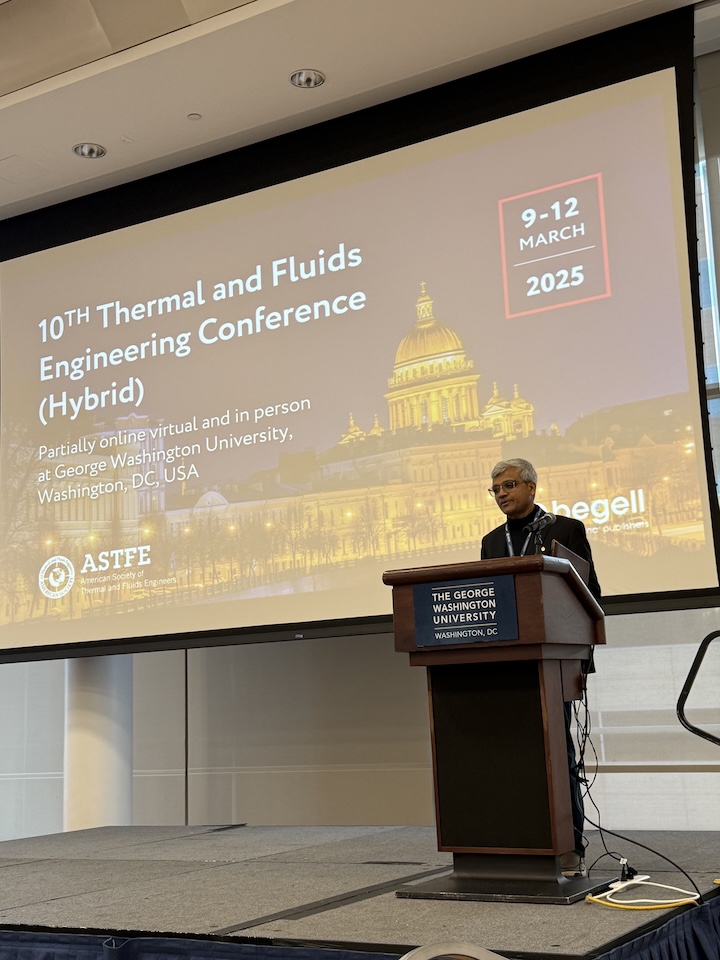
UNITING MINDS TO DRIVE INNOVATION IN THERMAL AND FLUID SCIENCES
From 4D bioprinting to cold plasma technology, the MAE Department is at the cutting edge of thermal and fluid science research. As co-chair of the 2025 Thermal and Fluids Engineering Conference, Professor Kausik Sarkar brought leaders from over 20 countries to GW.
The hybrid event welcomed 230 in-person and 70 virtual participants, capitalizing on GW’s accessible location in Washington, D.C., and funding from NSF and the Office of Naval Research. Combined with Department Chair Michael Plesniak’s role as Vice President of the American Society of Thermal and Fluid Engineers (ASTFE), the department made the ideal host. Plesniak also participated in a panel on funding opportunities in thermal and fluids engineering.
The department’s thought leadership in thermal fluids education was reflected in two MAE faculty-led panel discussions. Professor Saniya LeBlanc shared techniques for navigating educational challenges, while Professor Megan Leftwich discussed how to recruit and retain researchers who bring unique perspectives.
Ph.D. candidate Bengisu Sisik chaired the ASTFE student committee, and six other MAE students presented technical papers on topics like microbubbles for medical applications and the behavior of viscous drops in complex media.
“The conference enabled students to learn from field experts and each other, helping them gauge the impact of their research and collaborate,” said Sarkar.
Hosting the conference highlights the department’s role as a leader in thermal and fluid sciences, strengthening connections within the global community and advancing the field.
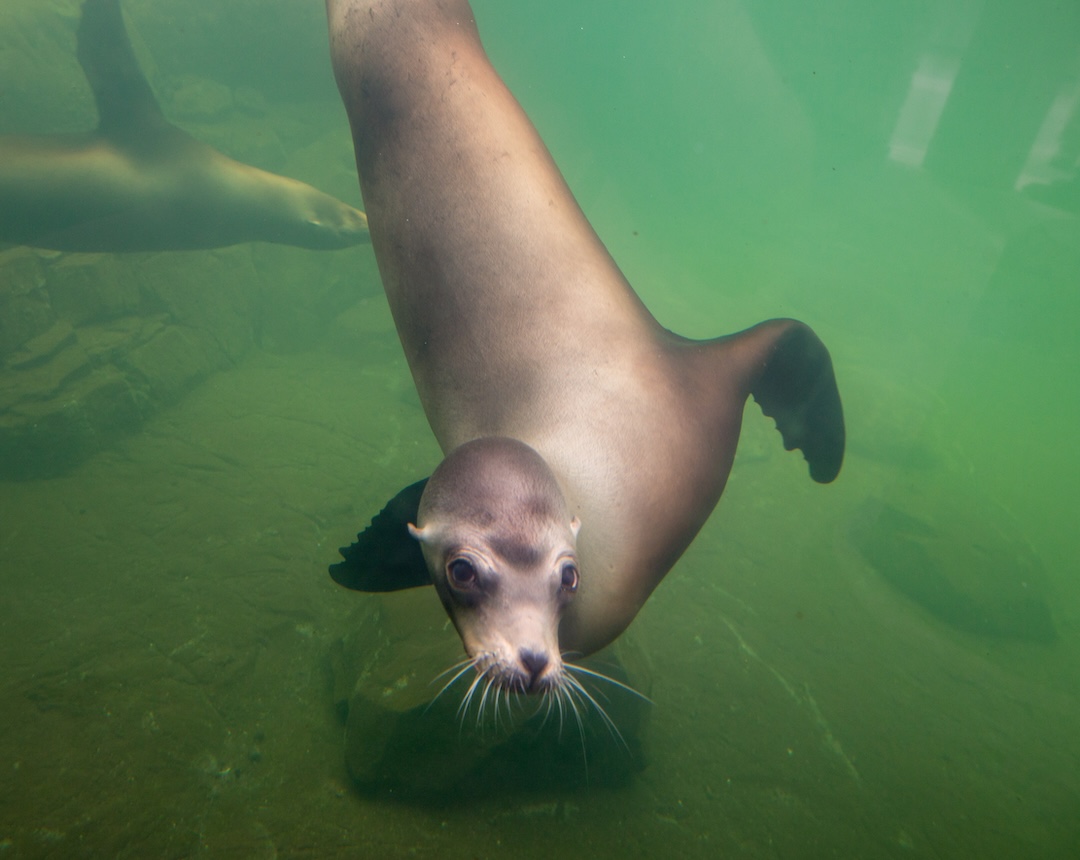
FOLLOWING THE FLIPPERS: UNDERSTANDING SEA LION MOVEMENT
When you think of sea lions, you may think of their playful antics and exuberant barks, but there’s much more to them than initially meets the eye and ear. Sea lions swim differently from other animals – primarily with their flippers, using their feet and tail for steering.
Professor Megan Leftwich works with collaborators from Westchester University and Drexel University to understand sea lion movement, like how they produce thrust underwater, enter and exit the water, and stabilize themselves.
Leftwich started researching sea lion movement twelve years ago, beginning with a collaboration with the National Zoo. The project began by exploring how sea lions swim, a topic that had not been thoroughly researched in recent years. Since then, Leftwich has been supported by several grants from the U.S. Navy.
As the Lead Principal Investigator (PI) on the project, Leftwich leads the GW team in designing the robot’s flippers and tail. The GW team is comprised of fluid dynamics experts who compare the flippers and tails of several types of sea lions and analyze their lift and drag to optimize the robot’s design.
After studying sea lions for over a decade, Leftwich is still amazed by their capabilities and excited to continue researching their unique movement. “There’s still a lot more to understand about their biology and physics,” she concluded.
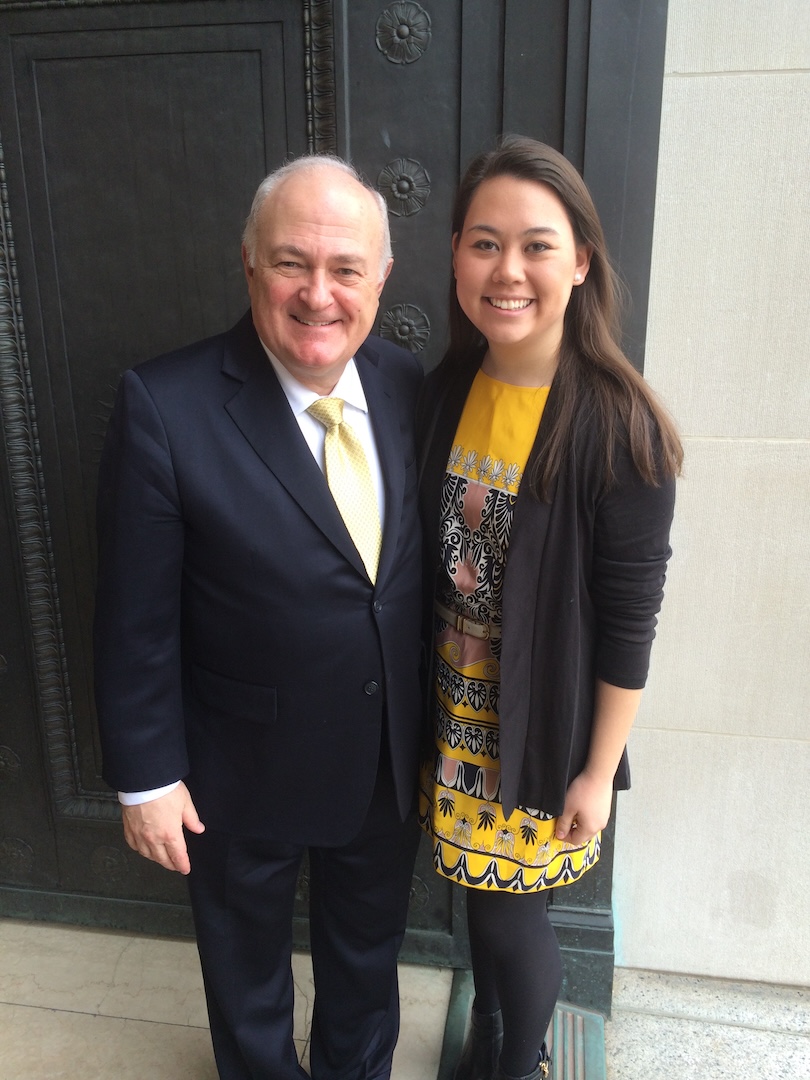
Elizabeth Hubler’s Path to Product Development that Puts People First
“How do we apply what we’re learning to directly improve someone’s life?” This ethos propelled alumna Elizabeth Hubler, B.S. ‘14, M.S. ‘17, through her mechanical engineering studies and into a career in product development.
While she always had an aptitude for math and science, Hubler credits her sister with introducing her to mechanical engineering. Her education in GW Engineering’s MAE Department gave her a broad foundation in not only technical knowledge but also problem-solving, collaboration, and communication skills. Through her involvement in Engineers Without Borders, role as a Dean’s Fellow, and master’s research in Professor Michael Plesniak’s Biofluid Dynamics Lab, she developed critical leadership skills that further enhanced her professional growth.
Hubler’s interest in product development began at LifeFuels, a startup beverage technology company, before she transitioned into the electric vehicle sector, designing vehicle accessories for Tesla and Ford Motor Company. In contrast, her master’s thesis focused on airflow through human vocal folds and the impact of voice disorders. Here, she learned the importance of navigating uncertainty, and she continues to apply the hypothesis-driven approach taught in the lab when developing products that solve consumer problems.
“Being comfortable with ambiguity is important for anyone entering the workforce, especially with new technologies always being developed. You need to balance the unknown with ways to push your project forward,” she said.
In her career, Hubler coordinates across multiple domains, working closely with cross-functional teams that help her design, manufacture, and distribute products. By presenting her graduate research at various competitions, she practiced synthesizing and relaying information to both technical and general audiences, which is critical in this incredibly interdisciplinary work, particularly when executive buy-in is needed.
“It may not seem like the most linear path, but I think it’s interesting how aspects from each experience in the department have played a part in my career,” she said.
Hubler’s journey serves as a powerful example of how a well-rounded education can open doors and foster personal and professional growth. She carries forward the department’s people-first mentality to ensure that her work advances technology while positively impacting people’s lives.
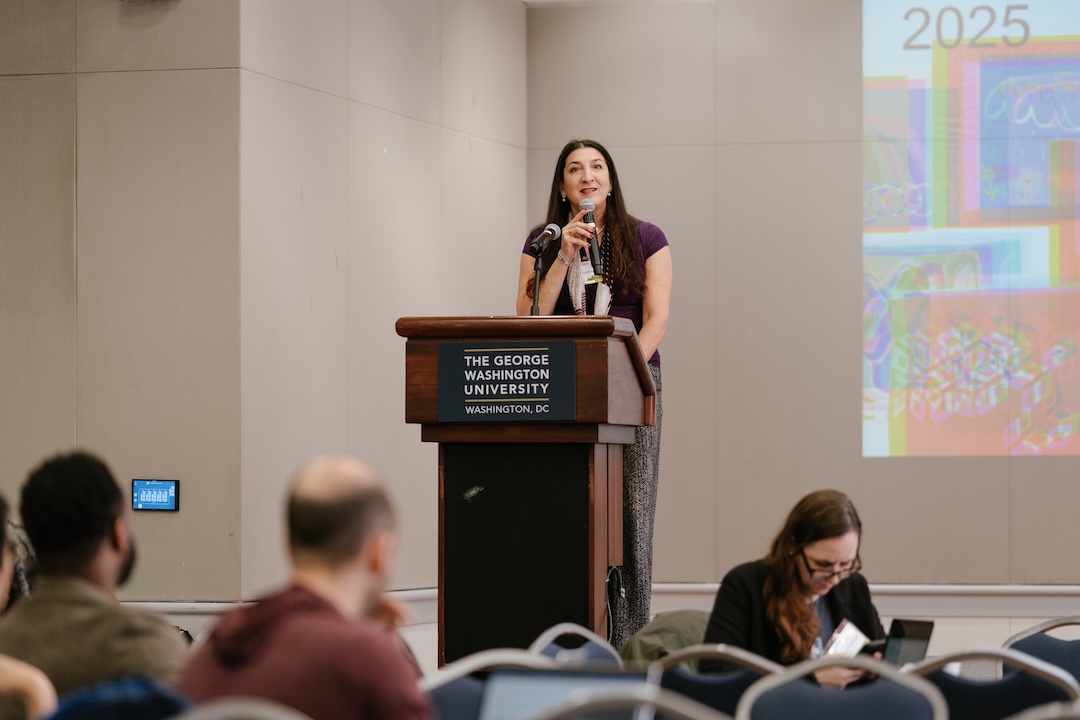
Open Source, Open GW: Driving Innovation Through Collaboration
We have never had more advanced technology at our fingertips. However, effectively building and using that technology requires a culture of collaboration. Professor Lorena A. Barba is the Faculty Director of GW’s Open Source Program Office (OSPO), which was created to promote a culture of open collaboration and knowledge sharing aligned with the university’s research and educational missions.
“In simple terms, open source means anyone can look at the code behind a program, use it, and even change it to fit their needs. In practice, this simple idea enables people to work together to build technology and share it with others,” Barba explained.
Barba and the OSPO encourage students to learn about open source software and engage with the communities that result from it. The OSPO has developed relationships with partners from industry and government to create internship opportunities where students can apply what they’ve learned from their open source projects. “It’s great for students’ professional development and is a way to build up their portfolio of job-ready skills,” Barba said.
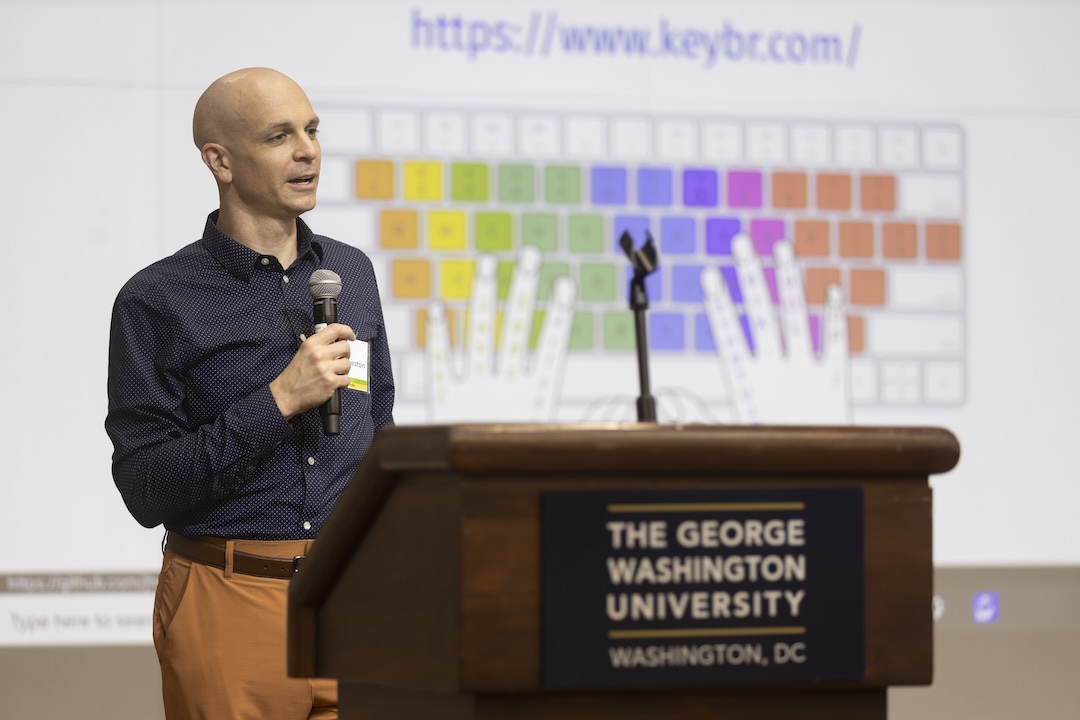
Funded by a grant from the Alfred P. Sloan Foundation, the OSPO leads several initiatives to empower the GW open source community. Initiatives in open research allow researchers to maximize the quality, reproducibility, and accessibility of their research, while open policy initiatives encourage GW community members to shape the national and local open source policy conversations.
The OSPO also dedicates resources to community-building initiatives that focus on cultivating a strong local open source community of GW faculty, staff, and students. As part of these initiatives, the OSPO hosted its inaugural Open Source Conference in March 2025 to bring GW and the broader Washington, D.C. community together to exchange ideas and express excitement about open source projects.
Barba is confident about the growing enthusiasm and engagement within GW’s open source community. “The first GW OSCON in March 2025 proved to be a resounding success and showed that people really want to be together to talk about what they are building and cheer each other on,” she concluded.
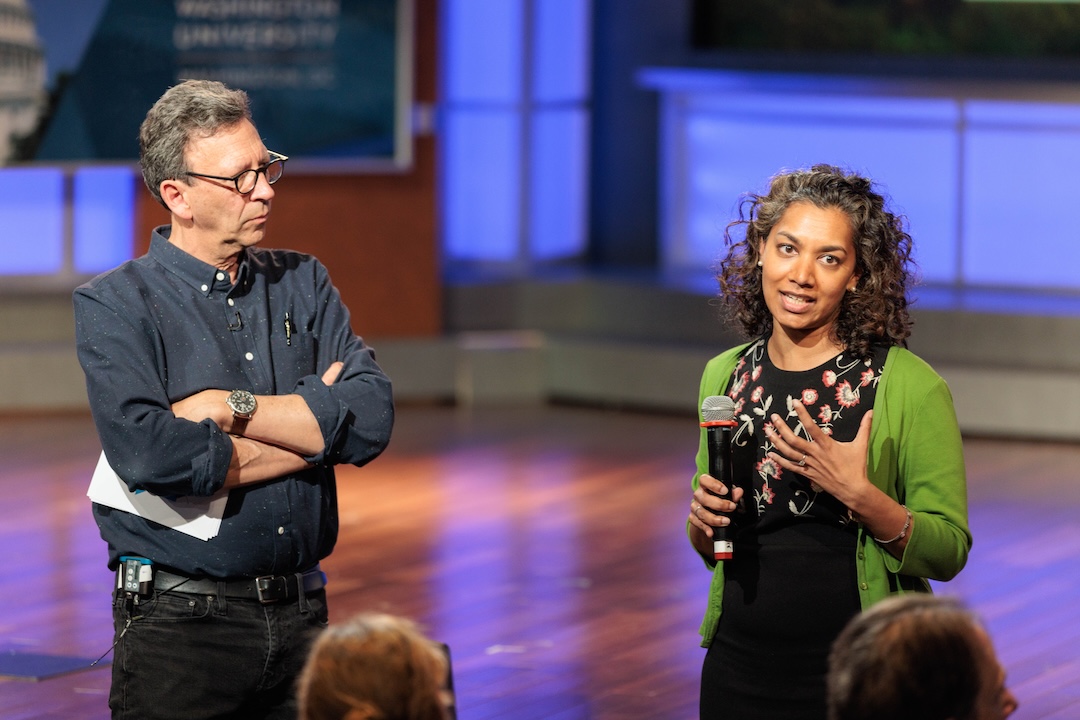
Engineering a Resilient Future: How LeBlanc Blends Research and Education
At the intersection of advanced manufacturing, materials science, energy conversion, and thermal transport, Professor Saniya LeBlanc is shaping a resilient future. Her efforts have not gone unnoticed; in 2025, she received the Presidential Early Career Award for Scientists and Engineers, the highest U.S. honor for early-career researchers.
This award builds on LeBlanc’s impactful NSF CAREER Award research, which explored how advanced materials behave under additive manufacturing techniques–known as 3D printing–to create next- generation energy conversion devices. For instance, she and her doctoral student contributed to a 2024 Nature Energy study introducing a method to alter thermoelectric material geometry for waste heat conversion.
LeBlanc’s research also tackles integrating new energy technologies in urban communities and military ships to advance sustainability efforts across sectors. Funding from the Department of Energy (DOE) and the Office of Naval Research supports her team in determining how advanced solutions like renewable power, energy storage, and alternative fuels could improve the system’s energy efficiency, resilience, and reliability.
Through Department of Defense grants, LeBlanc investigates advanced materials and manufacturing for hypersonic vehicles that travel faster than sound and generate immense heat. Her group applies its expertise in heat transfer to design protective materials and devices. Notably, a Defense University Research Instrumentation Program grant allowed them to develop cutting-edge additive manufacturing equipment with integrated sensors, enhancing the performance of high-temperature, energy conversion materials for integration in large systems.
LeBlanc connects her technical expertise with other disciplines for real-world impact. Her team’s thought leadership led her to become a faculty partner in the Chicago/DOE Alliance Center, where she collaborates with a vast network of experts to study material behavior in extreme environments. At GW, she co-teaches a class for engineering and business students, emphasizing the importance of bridging the gap between technology, policy, and finance to address global challenges.
For LeBlanc, integrity isn’t just about the work done in the lab–it’s about sharing this knowledge and staying true to her values. “Doing good work with integrity matters,” she says—a principle that guides not only her research but also how she mentors the next generation of engineers.
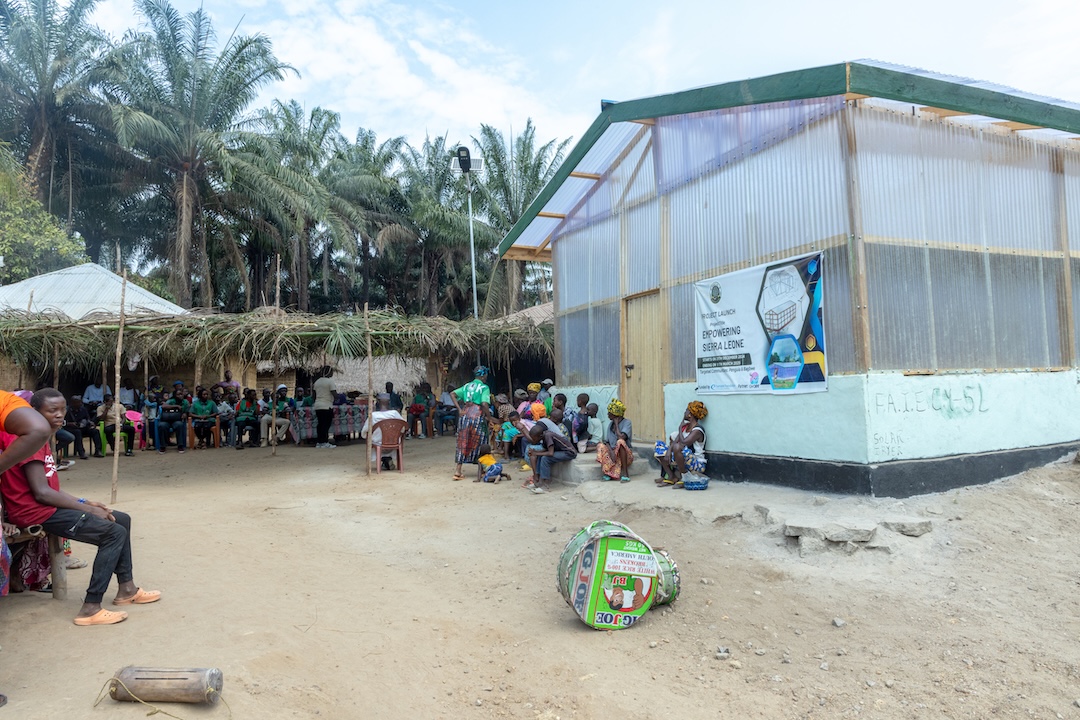
From Foggy Bottom to Sierra Leone: One Student’s Journey to Make an Impact
Tyler Wyka was drawn to GW because he wanted a school that would enable him to have strong relationships with his professors. What he didn’t realize until he got to GW, however, was how many other opportunities he would find on the Foggy Bottom campus and across the District. “You learn what it means to be at an engineering school that’s five blocks from the White House,” he said.
Wyka chose the MAE Department because it allowed him to explore his interests in physics, problem-solving, and fluid mechanics. He joined the 4+1 program, which gave him the opportunity to complete his B.S. and M.S. in just five years, focusing on thermofluids. Over his five years with the department, he joined Professor Saniya LeBlanc’s lab and got to work on the decarbonization of gas turbines for the U.S. Navy.
Wyka’s impact expanded far beyond the classroom and lab, however, as he took on a role as the President of GW’s chapter of the Association of Energy Engineers (AEE). His role introduced him to climate and energy conferences across the District, and led to his appointment as treasurer of the national capital board of AEE.
His most formative experience was his collaboration with Forum for Agriculture, Innovation, and Empowerment for Children and Youth in Sierra Leone (FAIECY-SL), which focuses on the modernization of climate change responses in Sierra Leone. Through his work in the D.C. climate conversation, Wyka met the FAIECY-SL founder, Michael Nabieu, and immediately inquired how he could support the organization. Wyka worked with his colleagues at GW AEE to fundraise for FAIECY- SL and apply for grants on their behalf, ultimately raising over twenty thousand dollars to build solar energy-powered structures to aid in food preservation.
All of Wyka’s experiences with the department can be understood as part of his desire to impact our world positively, and he credits the department with helping him refine his life’s purpose. “I want to encourage students to apply their engineering skills altruistically. You can have career stability and make a societal impact,” he concluded.


